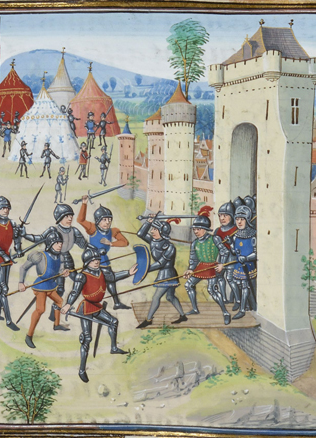Where Did Morta, the Wife of King Mindaugas, See Apes: the Natural Surroundings
The landscape of the old Lithuania
The orographic peculiarities of lands constituting the ethnic nucleus of the Lithuanian peoples are displayed in small yet numerous isolated heights spreading in trains. (Orography is a description of elements of the relief in regard to their configuration, size and direction.) The two largest among them are the Baltic Height, stretching from Masuria through Suwałki, Vištytis, Alytus, Trakai down to Drūkšiai, and the Samogitian Height. These, in turn, encompass smaller heights, such as Dzūkų, Aukštaičių, Švenčionių, Ashmyany (a large parts of which lie in today’s Belarus) etc. Heights were separated by stretches of lowlands and plains, such as the Karšuva Lowland, the Middle Lithuanian Lowland, and the Nevėžis Lowland, as well as the plains covering the upper reaches of Dysna and Neris (in Belarus), the Dainava Plain, and the height of Lida. Usually these fertile plains were the old areas of agricultural activity that lured since the middle of the 14th century the troops of the German Order who expected rich rewards there. Two large rivers, Nemunas and Neris, and plenty of their tributaries wound through the plains in addition to hundreds of lakes that had formed after the last Ice Age. Historical sources often refer to rivers, brooks, lakes and swamps as a natural element of the Lithuanian landscape in the 13th and the 14th century.
The land of bogs and marshes if the image granted to Lithuania by various writers in the old Rus’ and Western Europe, the image that has been confirmed on numerous occasions later.
Higher terrains were very important for Lithuanians. It was there that they built their castles and settlements around them, and it was there that the Grand Duke had his first lands which helped him consolidate his power and added to the defensive strength of the country. During the decades of fiercest fighting against the Crusaders, in the second half of the 14th century, the Samogitian Height accommodated the nucleus of the Samogitian lands surrounded by defensive wooden hedges. The heights of Medininkai and Ashmyany were a home for many old Lithuanian settlements. The rivers of Žižma, Gauja, and several left tributaries of Berezina, their headwaters in those heights, served as natural guides prompting Lithuanians to colonise the upper reaches of Nemunas.
Into the Woods…
The “endless” forests were the most characteristic feature of the Lithuanian landscape. In the 11th and 12th centuries, the forested area of Lithuania was two or three times bigger than now. Forests covered at least 55% of the current territory of the country, compared to just over 30% now. Today’s forests are a bleak reflection of what the forests were in the 13th and 14th centuries. Forests then, spreading tens and even hundreds of kilometres, were thick and naturally grown. Currently just several larger areas of the old forests remain, including forests of Gudai, Rūdninkai, Lavoriškės, Labanoras, Ažvinčiai, Šimoniai, Žalioji, Biržai, and Šešuoliai.
The first centuries of the second millennia, which in the climatic calendar was the beginning of the late sub-Atlantic era, offered slightly warmer and damper weather. That was the time of the “mediaeval warm period” dominated by pines, birches and, in some regions, alder and even spruce, hornbeams, oaks and hazels. The latter mostly survived since the end of the warm and damp period of early sub-Atlantic climate that came to an end at about 1000 AD. Spruce, oaks and hornbeams were abundant then. Spruce were especially widespread in the Samogitian Height and in the territories of the Central Lowland divided by largest rivers, according to scientists who study ancient forests. Pines were plentiful in the sandy plains of South-eastern Lithuania. Forests of wide-leaf trees, such as oaks, ash trees, elms, hornbeams, lindens, maple trees, were more common in the southern part of the Central Lowland, as well as in the Dzūkų Heights and the southern part of the Aukštaičių Height. The oak groves are the remnants of the old forests.
Historical sources from the 13th and 14th century almost never refer to largest forested areas, but provide some indications about the differences in the structure of forests and woods. They refer to hardly impenetrable thick woods as to wald, less thick coniferous woods are heide, oak groves are damerow, forest is grawde, wide and dangerous wildernesses are solitudo, wildnis, desertum, пуща. These were the characteristic words most often used by the warriors of the German Order raiding Lithuania from the second half of the 14th century to the early 15th century.
The Samogitians lands that the German Order raided in the late 14th century were separated from other territories by both wooden fences and vast stretches, ranging from one to four miles in width (one mile is 7.4 kilometres), of woods of different thickness and structure. For instance, the territory between the River of Viešvilė and the settlement of Nemakščiai was covered by a four-mile wood, with another forest surrounding the very settlement. Today’s Karšuva is what now remains of that unnamed woods. The sources of the German Order refer to the wood of Grodno, in the basin of the River Katra, as nasty: “On the way back from Grodno to Šalčininkai, via Pervalkas. (…) Two miles across the nasty woods before you reach Vosyliškiai, you can stay for two days here to have a good hunting. (…) From Šalčininkai, the way back leads through the woods (wilderness) wiltnis 12 miles to Pervalkas, to the royal place (…) after crossing Nemunas, you will reach a road again.”
The domesticated forest
Forest provided with honey and wax, hops and various foods, building materials and tools, warmth in winter and shelter in the times of trouble.
Hunters supplied furs, including most valuable ones, and animal skins. The First Statute of Lithuania (1529) listed the protected wild animals hunting of which was strictly forbidden with offenders facing fines. The list included wisents, moose, deer, bears, wild horses and mares, wild boars, roes, lynxes and beavers.
Do You Know?
Aurochs had already been eradicated, the first historically witnessed loss of the natural world in Lithuania caused by human activity. There were no monkeys in Lithuanian forests, but Morta, the Christian wife of Lithuania’s only king Mindaugas, either kept one as someone’s present or saw it in an illuminated manuscript where a monkey could serve as an illustration of the evil spirit.
For Lithuanians, just like for other Balts, woods, even the thickest ones, did not pose an obstacle to settle down, to develop agriculture or to communicate.
Forests, rivers and lakes were part of a natural everyday environment that people needed to overcome in order to live in it. Human activity changed landscapes, while the use of forest was the earliest and the most noticeable element in the shaping of the Lithuanian cultural landscape. Entering the forest usually started with allowing domestic cattle graze there, as well as grassland mowing, beekeeping and hunting.
Natural barren stretches, forest openings, areas along forest edges, river valleys, grasslands by lakes, upland moors, paths of wild animals of up to tens of kilometres long – all they served as human “windows” to nature. As time passed, people expanded deforested areas turning them into arable lands, pastures and grasslands. There they established their settlements.
Literature: Lietuvos istorija, t. 3. XIII a. – 1385 m. Valstybės iškilimas tarp Rytų ir Vakarų. D. Baronas, A. Dubonis, R. Petrauskas. Vilnius, 2011.
Artūras Dubonis




